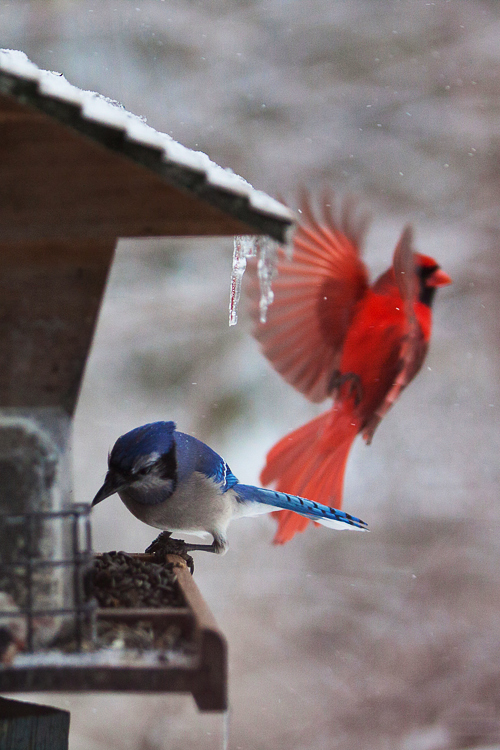
BY Lee McClellan
This is the second of a series of articles detailing essential outdoor skills to learn before the warm winds of spring arrive in Kentucky.
FRANKFORT, Ky. – The deepest, darkest, bleakest part of winter is here. The long slog from just after the holidays through the NCAA tournament is one of the toughest to weather, but watching the many species of birds that inhabit Kentucky in your backyard can brighten the most leaden days.

“Just this morning I didn’t want to leave from watching all of the birds in my backyard,” said Kate Heyden, avian biologist for the Kentucky Department of Fish and Wildlife Resources. “Winter is the best time to feed birds as they need the food now more than at any other time of year and you will typically see a greater number and variety of birds at bird feeders.”
Heyden said Kentucky receives many interesting birds from the north in winter and again in spring when many species return home from lands south of us, providing a great variety of species to see.
Bird watching is a good way to introduce kids into the outdoors and spark awareness of our natural world. It is also productive practice for bird hunters, who must make quick identifications of birds in the field. An identification mistake for a bird hunter can be costly as songbirds are protected under the Migratory Bird Treaty Act. Waterfowlers must know the species of duck or goose before attempting to take a bird or risk making a mistake in their daily bag limit.
“You don’t need to spend money on food or feeders to attract birds to your yard,” Heyden said. “If you can leave a small area of your yard un-mowed, you can attract a lot of birds. They eat the seeds from the grasses and weeds and use the area for cover as well.”
Employing a feeder grants the ability for close study of birds. Heyden explained all feeders draw birds, but those that keep the bird feed dry and free of mold are best. Moldy seeds are bad for bird health. Place feeders either near a window or fairly far away to help prevent birds from colliding with windows when startled.
The most common feeder is a hopper or house feeder, usually made of windows of clear plastic with that feed seed to a perching surface. These feeders attract cardinals, nuthatches, chickadees, grosbeaks, buntings and titmice.
“One without a lot of perching surface minimizes use by house sparrows or starlings,” Heyden explained. “The most important thing is to keep feeders clean by washing with bleach water every few weeks.” Washing with bleach water prevents the spread of disease.
Although slightly more expensive, Heyden feeds birds black oil sunflower seeds. “They attract a wide variety of desirable birds without attracting as many pest species,” she said. “The cheap bird feed is full of filler and often contains corn which attracts squirrels, house sparrows starlings and crows.”
A suet feeder attracts woodpeckers, nuthatches, chickadees and bluejays. Some birders push suet or peanut butter into crevices in bark or in the cracks of old stumps to attract these birds.
Witnessing a northern flicker or red-bellied woodpecker feeding at close range sears a delightful memory into the mind of a youngster. “Woodpeckers love dead branches on trees,” Heyden said. She recommended leaving a dead branch on a tree in the corner or rear of the yard to attract woodpeckers if it is safe to do so.
“It is important to provide water for birds in winter,” said Gary Sprandel, an avid birder and geoprocessing specialist for Kentucky Fish and Wildlife. Place the water in a spot in the yard that receives sun as its rays will melt some water for birds on even the coldest days.
A good guide book is essential for identifying birds. Looking up unfamiliar birds and learning about their distinguishing characteristics is part of the fun of birding. He prefers the “Birds of North America – A Guide to Field Identification” by Chandler Robbins. “I like this guide because all the information about a bird is on one page,” Sprandel said. “It is pocket-sized and easy to carry afield.”
Modestly priced binoculars now have coated lenses and other features that make them acceptable choices for bird watching. “Don’t get zoom binoculars for birding,” Sprandel said. “You tend to lose clarity at high magnification. A wide angle pair lets in more light and makes it easier to find birds. Try them out before you buy.”
Sprandel also invites backyard birders to participate in the Great Backyard Bird Count on Feb. 13 -16. This project from the Cornell University Lab of Ornithology, the National Audubon Society and Bird Studies Canada allows birders from all over the world help scientists glean valuable information on bird populations.
You simply need to record the species and number of birds seen for at least 15 minutes on one or more days of the project. To participate, visit the Great Backyard Bird Count homepage at http://gbbc.birdcount.org/.
Backyard birding is a family-friendly way to pass the long, dreary winter days. Plus, it is just plain fun.
Author Lee McClellan is a nationally award-winning associate editor for Kentucky Afield magazine, the official publication of the Kentucky Department of Fish and Wildlife Resources. He is a life-long hunter and angler, with a passion for smallmouth bass fishing.
-30-
The Kentucky Department of Fish and Wildlife Resources manages, regulates, enforces and promotes responsible use of all fish and wildlife species, their habitats, public wildlife areas and waterways for the benefit of those resources and for public enjoyment. Kentucky Fish and Wildlife is an agency of the Tourism, Arts and Heritage Cabinet. For more information on the department, visit our website at fw.ky.gov.


Be the first to comment